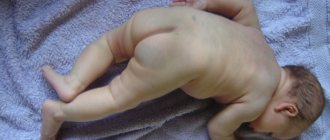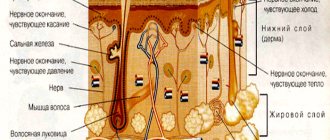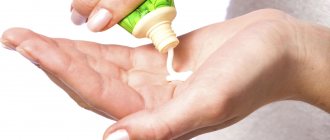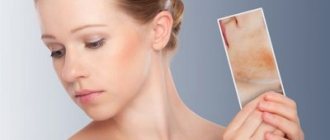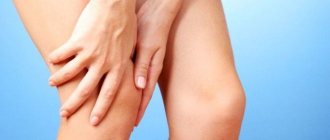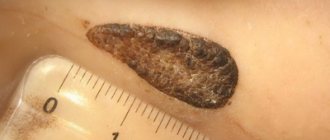Types of rashes
Spots are areas of a different shade from the surrounding skin. To the touch they can be smooth, protruding, or rough. Such manifestations on the surface of the skin are divided into 3 groups, which depend on the provoking factors and description.
- Vascular . Pinkish markings, available in red and purple.
In addition to this classification, there are separate types of marks related to certain pathologies. For example, ringworm. With it, papules disperse throughout the body. Depending on the type, they may also be on the head.
Vascular spots
| Name | Description |
| Hyperemic (blood) | Inflammatory and non-inflammatory. The first option arises against the background of current processes in the body. The size of the spots ranges from 2 cm (roseola) to 3-4 cm and above (erythema). The second option involves a rash that occurs as a result of an emotional outburst. Observed in the chest, neck, face |
| Hemorrhagic | Appear after a bruise or rough impact on the skin. They disappear on their own after 7-14 days. If bruises appear spontaneously and do not disappear for a long time, there is a risk of developing a disease that begins to affect blood vessels |
| Telangiectatic | These are spider veins that arise against the background of short-term dilation of blood vessels. Their occurrence is either congenital or acquired. There are many reasons for this - diet, bad habits, climate, temperature changes |
Dark spots
Markings of light and dark shades are observed on the skin if the amount of melanin has changed. The spots are:
- Hyper. The reason is increased pigmentation in a certain area. Congenital and acquired. The first includes birthmarks, the second - freckles.
- Hypo. The reason is a decrease in the amount of melanin. They also arise from birth and are acquired throughout life. The latter occur with psoriasis, lichen, and vitiligo.
Age spots may appear if you often go to the solarium. Also, the cause is prolonged lack of treatment in the presence of inflammation on the skin. For example, acne often leaves behind marks. This also includes burns, cauterization of pimples, and rough squeezing.
Pregnancy and hormone intake are common causes for the formation of spots. If a person is prone to freckles, age spots will not bypass him. Old age is also included in this list.
Before you start fighting pigmentation, you need to know what caused it. This is due to the fact that some stains go away on their own, without wasting money and time.
Video - Why do brown spots appear on the skin of the chest and back?
Photo of irritation under the mammary glands
Irritation under the breasts can occur as a result of wearing a low-quality bra.
Itching and redness under the mammary glands can be caused by various factors affecting the body. There may be a violation of hygiene requirements, poorly chosen underwear or low-quality skin care products. There are also more serious problems, the nature of which can be clarified by competent diagnosis.
The skin in the chest area is very sensitive and quickly reacts to external irritants with redness and itching:
- Pay attention to the quality of the underwear - its size should correspond to the size of your chest, and the fabric should be moisture-permeable and have a soft structure.
- Perhaps the reason is the washing powder, particles of which remain on the laundry and irritate the skin. It is worth changing the detergent to an analogue with hypoallergenic properties.
- New foods introduced into the diet or exotic dishes are a common cause of an allergic reaction. Review your diet and avoid new products of dubious origin. Perhaps the irritation between the mammary glands will go away in a few days. If this does not happen, you should look for other causes of the inflammatory process on the skin.
The appearance of fungus under the breast requires a comprehensive examination
A fungal infection that has entered a damaged area of skin can find a favorable habitat here. Especially when it comes to areas under the breasts, where intense sweating occurs and diaper rash occurs. For the fungus, such conditions are optimal, and its vital activity will soon make itself felt with itching and red spots under the breasts.
Hyperhidrosis
During the hot season, the area of skin under the breasts is often covered with patches of diaper rash. Redness under the mammary glands is a consequence of intense sweating and the accumulation of moisture in a closed environment, which is formed by thick underwear and folds between the mammary glands. To cope with the problem, following the rules of personal hygiene, taking a shower several times a day and using cosmetics with a drying effect.
Breast diseases
Lactostasis
Bright red spots under the mammary glands often appear during lactation. If the patient experiences stagnation of milk - lactostasis, the breasts swell due to excess fluid, a burning sensation and itching appear. The process is accompanied by hyperemia, which can only be dealt with by treating the underlying disease.
Often, redness and itching under the mammary glands is a symptom of a tumor process. For example, an itchy rash is a sign of an inflammatory cancer. The process proceeds quite quickly and requires surgical treatment to prevent the inflammation from spreading to neighboring areas of the body.
Scabies mite
Parasitic insects find a favorable moist environment on the surface of the skin under the mammary glands. Their activity causes severe itching and redness of the skin. Symptoms become more pronounced at night, which most likely indicates damage to the body by scabies mites.
Psoriasis
Medical research shows a connection between the appearance of red spots under the breasts and diseases such as psoriasis, rubella, measles or chickenpox. Their course immediately affects the condition of the skin, causing a rash or inflammation in a focal or continuous form. As a rule, with successful treatment of the underlying disease, hyperemia disappears without a trace within a few days.
Often itching and redness of the skin in the mammary glands indicate hormonal imbalances during pregnancy or lactation. As hormonal levels stabilize, inflammation disappears within a few weeks without special treatment. If a patient of puberty age who is not pregnant or lactation complains of redness, the symptom indicates a lack or excess of hormones. An appropriate blood test and taking medications prescribed by a specialist based on the results of the study will help clarify the clinical picture.
Diseases accompanied by hyperemia in the chest area include atopic dermatitis and diabetes mellitus. In addition, redness of the skin may accompany a decrease in immunity due to a previous illness or poor lifestyle. A comprehensive diagnosis aimed at detecting all possible diseases associated with inflammatory processes on the skin allows you to make an accurate diagnosis or refute initial suspicions.
Red spots on the skin
Every person has had strange spots on their skin at least once. Red spots appear for many reasons. However, they can be a slight irritation and indicate a deadly condition. If changes in the skin are observed along with fever, swelling, pain, itching, then it is important to seek help in time.
- Allergies to foods, sunlight, household chemicals, medications.
- Dermatitis.
- Lack of vitamins (seasonal).
- Low immunity.
- Infections.
- STD.
- Stress.
Rash due to illness
People, especially men, do not always pay attention to changes in skin tone in certain places. The reason for their appearance may be various factors. It is important to diagnose a provocateur. By eliminating it, the stains will also disappear. In the stronger half of humanity, red marks are more often associated with the following “pathogens”:
- Poor nutrition, frequent snacking.
- Allergy.
- Stress, nervous tension.
- Alcohol, smoking.
A red rash signals a malfunction of the internal organs and the hormonal system. In men, problems with the heart and blood vessels are often a provoking factor. If a person is 40+ and has pink marks on the back or all over the body, they should immediately consult a dermatologist.
Itching due to skin pathologies is not an independent phenomenon or a separate disease. If the spots itch, then this is a signal of the presence of an inflammatory process. The most common are:
- Measles . A dark rash behind the ears, then spreading throughout the body.
- Ringworm . Red plaques, dryness, and slight itching appear.
- Eczema . Itchy blisters form on the skin.
- Psoriasis . Redness occurs along with white flakes on the skin and incessant itching.
- Chicken pox . There are several developmental stages during which plaques cover the entire body. Itching is an integral part of the disease.
- Allergy . The spots appear anywhere on the body. The reason is an unsuitable product or substance.
- Lupus erythematosus . The spots that appear provoke complications and changes in the functioning of all organs. Without timely and competent treatment, hemorrhage is possible.
On a note! Each of these diseases occurs with itching. Some are easy to treat, others require medical help.
Spots and pimples
Often acne is associated with redness of the skin in the back area. The reason for this is the many glands that produce sebum and fat. If such changes occur, this indicates violations such as:
- Skin irritation after contact with synthetic material.
- Allergic reaction.
Sometimes the problems are more serious: disruption of the gastrointestinal tract, intestinal obstruction. In these situations, it is important to adjust the menu and go on a diet prescribed by a doctor. Also, acne spots may appear if a person spends a long time under the sun. In this case, the body communicates in this way about the presence of inflammatory processes. It is important not to miss the moment - to undergo a full examination.
Redness on the back and shoulders
In some cases, irritation occurs not only on the back, but also on the shoulders. This is a sign of pathologies such as:
- Allergy . It occurs against the background of contact with various substances and tends to affect the entire body.
- Ringworm . It also occurs anywhere, starting from the arms, including the back and shoulders.
- Infections . The spots are accompanied by small pimples on the back, shoulder area and most of the body.
Attention! In almost all cases, large plaques require immediate attention to a specialist. Proper treatment will help avoid unpleasant consequences. If redness occurs due to infection, the person is isolated because he becomes contagious.
Rash on the stomach and back
If red or pink marks are also observed on the stomach, except on the back and shoulders, then this is a signal of a malfunction of the intestines, liver or kidneys. Red marks appear in 4 cases:
- Urticaria . The causative agent is some external factor or a consequence of the body’s allergic response to medications.
- Erythema . The spots spread all over the body.
- Psoriasis . Redness with a flaky white surface is observed. Affects large areas of the body.
- Ringworm . There is no specific localization, the peeling is insignificant. Red plaques in large numbers on the back.
If any of the listed pathologies is present, self-medication is unacceptable. Qualified medical assistance is required.
Lumpy spots
If you want to learn in more detail about the occurrence of a lump on the back, and also consider the possible causes of its appearance, diagnosis and treatment methods, you can read an article about this on our portal.
If a red spot appears on the back, which itches and has a lump in the center, then dermatitis, herpes, eczema, rubella or a closed pimple can be diagnosed. These manifestations should not be ignored, since this rash tends to spread throughout the body. Treatment is individual.
Allergic reactions and infections
Redness is caused by an allergic reaction.
What could cause it:
- cosmetic components;
- plant pollen;
- animal hair;
- product ingredients;
- medicinal compounds.
Allergies are caused by fabrics made from synthetic fibers. The rash and irritation often have the appearance of abscess formations. They should not be squeezed or combed, so as not to introduce even more microbes and increase the area of damage.
Rashes on the chest appear during the development of infectious diseases. Each type of disease has its own special type of red spot, but this is a mandatory symptom of the disease.
You can study their features to understand their character:
- Measles: red spots in the form of papules of varying sizes.
- Chickenpox: bright, mottled blisters of varying sizes. Redness appears around the bubbles, but the impression is of single red islands.
- Scarlet fever: small red dots.
The redness may not have a rash, the whole body becomes bright and inflamed. There will be no changes to the touch; other types of infections have such signs: rubella, viral hepatitis.
Scleroderma
Focal scleroderma is observed in adults and children. Women suffer from this disease more often than men. The disease has two types:
At first, one or more red spots appear on the skin. They are also found with a lilac tint. In the second case, internal organs and skin are affected. They become shiny, with a dense surface.
Infectious diseases
Measles, rubella, scarlet fever, chickenpox are infectious processes. Marks and blisters appear on the body. These diagnosed diseases imply that the patient is isolated from society.
It may manifest itself against the background of a cough or fever. The rash starts on the face and goes down to the heels. In appearance it looks like red bumps that can merge into one large spot. Even after the illness ends, marks may remain on the skin.
Rubella
This is a small rash accompanied by fever. The virus reaches humans through the air. At the initial stage, you feel unwell and weak. Body temperature does not exceed 38 0. A little later there is a runny nose. Then a rash begins to appear in the face area, and further along the body. Spots – 6 mm. Complications from this pathology are more common in adults.
Scarlet fever
The disease develops when streptococcus enters the body. Usually accompanies a sore throat. The rash is small, covers the entire body, and is pink in color. A few days after the onset of the disease, the skin begins to peel off. The onset of severe symptoms begins in the neck, moving to the upper back and chest area.
Chickenpox
Chickenpox occurs against the background of the herpes virus. At the beginning, a red tubercle appears, a little later a vesicle rises on it. Further rashes spread throughout the body. When pimples dry out, new ones appear. They are accompanied by elevated temperature.
If you want to learn in more detail why the skin on your back hurts, and also consider the causes, symptoms and treatment methods, you can read an article about it on our portal.
Video - Spots on the skin
Concomitant pathologies
Further treatment is determined by the type of tumor. When examining independently, it is not always possible to accurately determine the type of rash, since some diseases have similar symptoms. It is necessary to pay attention to the absence/presence of peeling, itching, swelling, and changes in pigmentation in the affected area. Infectious pathologies are often accompanied by weakness, headaches, and high fever.
Ringworm and psoriasis
Lichen. Infection occurs through contact with a sick animal or person. Full maturation of lichen occurs in 1-3 weeks. First, a red or pink spot appears that is flaky and itchy. In the abdominal area, Gibert's disease or pityriasis rosea is most often diagnosed.
Psoriasis belongs to the group of autoimmune diseases and does not pose a danger to others. Dry plaques have a reddish tint and are covered with a whitish coating on top. The size of the tumors varies from five millimeters to several centimeters. The initial stage is characterized by the appearance of spots in a certain area (legs, arms, lower abdomen); in advanced forms, psoriasis affects the entire body.
Scarlet fever. It is considered a childhood disease, but is often diagnosed in adults. The occurrence of a rash is accompanied by the development of tonsillitis (a white coating is noticeable on the tonsils, the pharynx becomes covered with mucus) and an increase in temperature. The spots are localized on the stomach, chest, neck and/or back, they are very itchy and flaky. After 5-7 days, the symptoms fade away.
Rubella. Redness occurs almost throughout the body, including the abdominal area. On palpation, small tubercles are felt, and swelling of the affected areas is noticeable. The process is accompanied by headaches, high fever, nasal congestion and cough. If the spots do not bother you in any way, treatment may not be required.
Measles. An acute infectious pathology, which is characterized by the appearance of red rashes on the mucous membranes and skin. The virus enters the human body through the respiratory tract, after which it migrates into the circulatory system. Initially, the rash appears on the head, gradually spreading to the back, abdomen and limbs. For preventive purposes, vaccination is carried out, which is valid for 10 years.
Other diseases
Atopic dermatitis. A disease of an allergic nature and provoked by mast cells, eosinophils, lymphocytes and other provocateurs of inflammation in the deep layers of the epidermis. The main symptom is itchy skin. When mast cells decompose, they release histamine, which causes a burning sensation.
Complex therapy is carried out using drugs that suppress the production of histamine (Loratadine), as well as blocking beta-andrenergic receptors (Salbutamol). In addition, corticosteroids are prescribed, most often ointments (Dexamethasone, Fluticasone).
Diseases of internal organs. Pathological changes in the thyroid gland, disruptions in the gastrointestinal tract, as well as hormonal imbalances are accompanied by the appearance of red spots on the skin of the abdomen, back, and limbs. This is due to the ridding of the body of toxins and other harmful substances. In this case, the rash does not require medical intervention and goes away on its own after some time.
Diagnosis and treatment
The cause of the rash is determined by a specialized doctor. As a rule, a visual examination first follows, then tests and additional examination are prescribed. It is useless to describe the rash in words or in correspondence - it is impossible to make a diagnosis in this way, just like on your own. Therefore, if “unhealthy” spots appear on the skin, you need to make an appointment with a dermatologist. If there is a suspicion of a skin pathology, it may additionally be recommended to take a scraping from the affected area for further examination.
Treatment of rashes should be under the guidance of a physician. His task is to prescribe effective and appropriate therapy. In cases of chickenpox, measles and rubella, there is no need to take a course of antibiotics.
If we are talking about a rash due to the presence of scabies mites, then the treatment will be simple. Rashes of an allergic nature require taking samples and prescribing treatment to eliminate the pathogen. Non-infectious skin diseases do not go away on their own; proper treatment is required, taking into account all the characteristics of the body.
Any spot of unknown origin on the body should be shown to a dermatologist if there is cause for concern. Do not voluntarily take medications not prescribed by a doctor. If treated incorrectly, there is a risk that the disease will worsen and then more serious treatment will be required, including hospitalization.
Spots on the back: photos, possible diseases, symptoms
Spots on the back can appear at any age and for a variety of reasons. Moles and freckles are nothing to worry about, but there are other types of rashes that look disgusting or disguise themselves as harmless pigmentation.
Unusual spots may be the result of hormonal imbalances, which disrupt the production of melanin pigment. Therefore, pregnant women or women during menopause notice brownish rashes on their bodies. In older people, they appear due to aging skin. Also one of the reasons is a lack of vitamins. Genetic predisposition and individual skin characteristics play an important role.
If the rashes are only a cosmetic defect, you can get rid of them with the help of cosmetics or home remedies, or salon procedures. But if the defect is based on a disease, you first need to deal with the root cause, otherwise eliminating pigmentation will not be effective.
Diseases that cause spots on the back
Typically, rashes on the torso are a symptom of skin diseases. But pigmentation on the back is not always a sign of dermatitis. Here are the main diseases associated with the appearance of spots on the back.
- Vitiligo. White spots on the back and other parts of the body due to the destruction of melanin. This happens under the influence of heredity, decreased immunity, and impaired skin trophism. Other causes include hormonal disorders, gastrointestinal diseases, and chemical burns. In this case, the lightened areas can be flat or raised. Some have a bluish tint. The disease itself is not dangerous, but it is often accompanied by disturbances in the digestive system, various dermatitis, and eye inflammation. Different forms of the disease require special treatment. It would be good if we could find a connection between vitiligo and another pathology. Otherwise, therapy will be aimed at restoring melanin production and eliminating cosmetic defects, which is not always effective.
- Angioma of the spinal cord. Pathological growth of the vascular wall into a benign tumor. It threatens the destruction of nerve endings responsible for movement and internal bleeding. A brown spot appears along the spine, which increases in size over time. The skin becomes numb and tingling is felt. Pain occurs, radiating to different parts of the body. A small tumor requires conservative treatment and medical supervision. A rapidly growing tumor is removed surgically.
- Syphilis. An infectious disease, most often sexually transmitted. The causative agent is Treponema pallidum. If left untreated, after the incubation period is completed, the disease progresses to the next stage. Secondary syphilis is characterized by light rashes over the collarbones and shoulder blades, vascular pink and red spots on the back and limbs, and hair loss. Lymph nodes are enlarged but painless. Body temperature rises, cough, runny nose and conjunctivitis appear. Such symptoms last for 1-2 weeks, then disappear. The disease enters a chronic stage with damage to internal organs. Penicillin antibiotics are used for treatment.
- Infectious diseases. Diseases such as rubella, scarlet fever, measles, chickenpox are characterized by a strong increase in temperature and profuse rashes in the form of red spots, blisters with liquid, pimples, itchy blisters. Patients are prescribed local treatment, taking antibacterial drugs and vitamins, as well as complete rest during the recovery period.
- Eczema. Non-contagious inflammatory skin disease. It is a consequence of allergies, hormonal and nervous disorders, and metabolic failure. It can also be caused by microbes and fungi. There are several types of the disease, but they have common features. The affected area turns red and becomes covered with ulcers and blisters with purulent or serous contents. After they heal, plaques covered with scales remain on the skin. At the same time, itching and burning are felt. Patients are prescribed antihistamines, drugs for skin healing and regeneration, and diuretics to speed up blood filtration.
- Pityriasis versicolor. Fungal disease of the stratum corneum of the epidermis. Characterized by the appearance of yellow, pink and brown spots on the back and chest. The rash gradually merges with each other, forming extensive foci. Their shade is constantly changing. Therefore, the second name of the disease is lichen versicolor. To eliminate the pathology, antifungal drugs are prescribed for external and internal use. Exposure to ultraviolet light helps to overcome the pathogen, so sunbathing is beneficial. Other types of lichen (squamosus and rosea) also cause rashes on the back.
Of all the above, only tinea versicolor does not pose any threat to health even in the absence of treatment. The only discomfort is the appearance of many brown spots on the skin.
Video on how to recognize dangerous spots
Red spots on the breasts of women in most cases are a normal rash or indicate other skin conditions. However, this symptom may be a visual indicator of breast cancer.
Women who know the first signs of breast cancer can recognize malignant changes in time. This will allow for rapid diagnosis and treatment of cancer at an early stage, which significantly improves prospects.
In the current article, we will explain whether red spots or rashes on the breasts could indicate breast cancer.
We will also look at other causes of red spots on the chest and tell you when you should see a doctor if you experience this symptom. The content of the article:
Spots on the back photo
How to get rid of it?
If such a defect appears, you should consult a dermatologist. He will conduct the necessary research, prescribe treatment or select a safe way to eliminate unwanted pigmentation.
Products based on salicylic alcohol, citric acid, and hydrogen peroxide have a good whitening effect. You can buy them at the pharmacy or prepare them yourself. It is important to strictly follow the dosage to avoid burns. Beauty salons offer procedures to get rid of stains:
- cryotherapy (exposure to liquid nitrogen);
- laser removal (removal of the top layer of skin with a light beam);
- mesotherapy (administration of drugs with a whitening effect);
- peeling (partial removal of the epidermis with chemicals).
Prevention of such rashes is proper nutrition, strengthening the immune system and dosed exposure to the sun. You should take a responsible approach to the choice of detergents and cosmetics. Hormonal medications can only be taken as prescribed by a doctor.
Not all spots on the back are harmless. Sometimes unusual pigmentation is one of the symptoms of a dangerous disease. You should not try to deal with it on your own; if it appears, you should consult a dermatologist.
source
Symptoms and treatments for chondrocalcinosis
Chondrocalcinosis is damage to the joints associated with the deposition of calcium salts in them. The disease most often occurs in old age; it can “masquerade” as other pathologies and therefore is not always detected in a timely manner. In most cases, patients are diagnosed with pseudogout, a form of chondrocalcinosis. But other types of disease cannot be ruled out.
In the article we will look at how chondrocalcinosis is classified, what symptoms it manifests and how it is treated.
- Causes of chondrocalcinosis and risk factors
- Classification of chondrocalcinosis
- Symptoms of chondrocalcinosis
- Diagnostic methods
- Treatment of chondrocalcinosis
- Treatment with folk remedies
Causes of chondrocalcinosis and risk factors
Chondrocalcinosis, like pseudogout, is a consequence of various diseases. That is, calcium salts are deposited in the joints due to an increase in their concentration in the blood or due to metabolic disorders. The most likely diseases and abnormalities in this case are the following:
Our readers successfully use SustaLife to treat joints. Seeing how popular this product is, we decided to bring it to your attention. Read more here...
- osteoarthritis – damage to the cartilage of the joints;
- hyperparathyroidism is an endocrine disease in which the functions of the thyroid gland are disrupted;
- hemochromatosis is a hereditary disease in which the iron content in tissues increases;
- decreased magnesium levels;
- permanent joint damage;
- irradiation.
It can be concluded that the root cause of chondrocalcinosis is genetic abnormalities and diseases that cause metabolic disorders. Therefore, diseases that have a similar development mechanism are also secondary factors. For example, with diabetes, metabolism is also disrupted, which can cause salt deposition in the joints.
There are two known risk factors. The first is genetic predisposition. If a person has close relatives suffering from diseases that cause metabolic disorders or chondrocalcinosis, the risk of developing the described disorder increases by 1.5 times.
The second factor is old age. It has been established that in elderly people under 75 years of age, pathology is detected in 14% of cases, and in people over 80 years of age this figure reaches 80%. In fact, the percentage of detection of chondrocalcinosis could be higher, but doctors often make the wrong diagnosis.
Classification of chondrocalcinosis
In rheumatology, two types of classification of chondrocalcinosis are used: according to the reasons that caused the disorder and according to the accompanying clinical signs. If we talk about classification by etiology, three forms can be identified:
- idiopathic chondrocalcinosis – cases in which it is impossible to determine the cause;
- familial chondrocalcinosis - cases where hereditary and genetic provoking factors are identified;
- secondary chondrocalcinosis - pathology develops against the background of previous diseases, often combined with gout.
The first two forms are practically untreatable. The doctor can only prescribe symptomatic therapy aimed at eliminating unpleasant symptoms. You cannot completely cure a disease without knowing the cause or without having leverage over it.
Based on clinical signs, chondrocalcinosis can be divided into four types.
- Pseudogout - has the most cases of diagnosis, is characterized by damage to large joints, most often the knee.
- Pseudoreumatic arthritis - has a chronic course, most often manifests itself in the joints of the hand. Over time, it leads to joint deformation. The symptoms of the form are similar to rheumatoid arthritis.
- Destructive chondrocalcinosis is the most severe form, which affects several joints at once. Occurs in older people over 65 years of age.
- Latent form. It occurs without symptoms and is discovered by chance during examination of other diseases. Easily treatable.
There is another form that is rare - antipathic chondrocalcinosis. It is characterized by a sluggish course and the absence of clear symptoms. Most patients report constant but moderate pain in various joints - elbow, shoulder, hand and spine.
Symptoms of chondrocalcinosis
Signs of the disease are different, depending on the course and form. You can see them in the table.
| Pseudogout | Acute pain, swelling and redness of the skin in the joint area, increased local temperature. Movement restrictions may occur. |
| Pseudoreumatic arthritis | Pain in small joints, their deformation and decreased function. A characteristic symptom is morning stiffness. |
| Destructive | Severe pain in several joints at once, development of swelling, redness of the skin. Increased body temperature during exacerbations. |
| Latent | There are no symptoms. |
| Antipathetic | Moderate and constant pain, slight swelling. Limitation of movement in the affected joint. |
Ringworm Zhibera
Infectious-allergic skin lesions. The causative agent is unknown. Some scientists believe that this is one of the herpes viruses. Exacerbation of pathology occurs when immunity decreases, usually in spring or autumn after suffering from colds. A single oval pink spot appears on the patient’s body.
Over time, its center turns yellow and becomes covered with scales. After a few days, multiple rashes with a flaky surface form. Possible itching. Ultraviolet light is used to relieve symptoms. Anti-inflammatory and hormonal ointments are also applied. For severe itching, taking antihistamines is indicated.
Chronic skin damage that occurs due to stress, the use of certain medications, and malfunction of the endocrine and digestive systems. Immune and metabolic disorders may also be the cause. The pathology is characterized by the appearance of red spots on the abdomen up to 0.5 cm in diameter. They are slightly raised above the surface of the skin, and their central part is slightly concave.
The surface of the rash is shiny and flaky. Clusters of inflammation form a pattern in the form of garlands, rings or lines. Patients complain of severe itching. Patients are prescribed sedatives. Treatment of lesions with hormonal ointments is also indicated. In addition, physiotherapeutic procedures are carried out.
A fungal disease affecting the stratum corneum of the epidermis. It is also called versicolor or solar lichen. An exacerbation of the infection can be provoked by a decrease in local and general immunity, increased sweating and endocrine disorders. Patients develop round spots on the stomach, back and arms up to 1 cm in diameter.
Their colors are brown, yellow and pink. The surface of the affected areas peels off, but there is no inflammation or itching. The resulting physical discomfort indicates the addition of a secondary bacterial infection. As they grow, the pigmented areas merge. Their size can reach 15 cm. The edges are clear and uneven.
This is only a small part of the diseases that provoke the appearance of unusual pigmentation on the abdomen. Any dermatological pathology and a number of systemic ones can cause such a symptom. To identify the cause, complex diagnostics is sometimes required. And treatment is possible only under the supervision of a specialist.
We suggest you read: A rash on the body of an adult itches: how to treat rashes with itching
